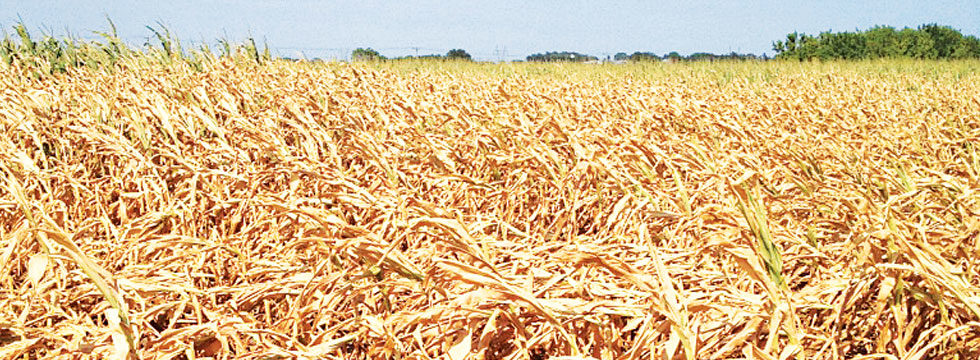These areas, however, have been few and far between, with the majority of eastern Canada experiencing some form of drought stress.
For many this was moderate, certainly taking the top-end yield out of the picture but, overall, nothing too serious.
For others, it has resulted in a total crop failure with corn not breaking your belt in terms of height and yield predictions in the 30- to 50-bushel-per-acre range.
Variable is really the only way I can think of to describe this year’s corn crop and therefore corn silage. I for one hope that we will not have to deal with such a crop again but, just in case we do, the following will provide some helpful management guidelines for a drought-stressed crop.
In-season considerations
In order to understand why we might see the results we do in either our field yields or nutrition levels of our drought-stressed corn silage, it is important to know a little bit about the physiology of the corn plant.
Knowing when the stress will affect the plant most allows us to be better prepared come harvest time. On average corn utilizes 24 to 27 inches of water per acre during the growing season.
The four-week period surrounding silking is the most important time. Repeated moisture stress during the silk-to-tassel stage can result in grain yield losses as high as 50 percent. Depending on hybrid maturity, it takes between 40 to 50 days to reach half milk-line maturity from 50 percent silk.
For corn silage yields, the drought can potentially have a greater impact. This is due to the fact that, depending on the timing of the stress, we may not only see a reduction in grain yield but also a significant reduction in plant height.
Not all hybrids handle drought the same. If you have some lighter land or are concerned about a shortage of precipitation in the coming years, it would be worthwhile asking your seed representative which hybrids will perform better under a drought situation.
Harvest considerations
When the time comes to harvest corn silage that has experienced drought stress, the harvest considerations are very similar to what we would have in a “normal” crop.
Drought-stressed corn can look very dry standing in the field, but has the ability to hold quite a bit of moisture in the stalks.
This makes it very important to chop some stalks prior to harvest in order to ensure we are ensiling the crop at the proper moisture.
The tendency with a stressed crop is to harvest too wet, which can lead to many problems down the road with both fermentation and runoff, resulting in the loss of valuable sugars from the silage.
If the corn has any grain, the kernel milk line can be a guideline to determine the proper time to chop but, given the variability in drought- stressed corn, plant sampling is still the best approach.
In general, when the milk line is one-half of the way down the kernel, it can be chopped for bunker silo storage without incurring significant effluent losses.
When the milk line is two-thirds to three-fourths of the way down to the kernel tip, whole-plant moisture is 63 to 68 percent. Whole-plant moisture is typically 50 to 60 percent as the black layer begins to appear at the kernel’s tip.
Corn plants that are moisture-stressed have suppressed plant health, which increases the opportunity for pathogens such as yeast and moulds to more easily infect the plant.
High dry matter, low-compaction-density silages (due to lower grain content) may further cause problems by not achieving the desired pH or anaerobic conditions that provides an environment suitable for further yeast and mould activity in the silo.
The final feeding consideration for low-grain, drought-stressed silage is the high sugar content that will exist even after fermentation is completed.
The high sugar content provides substrate for the growth of spoilage organisms, leading to the potential for silage heating and poor bunklife/palatability, especially in the warmer months.
This combination makes it advisable to use a heterofermentative inoculant product containing Lactobacillus buchneri in order to both properly ferment the crop and reduce heating and spoilage at feedout.
In a year such as this, with high feed prices and low forage inventories, producers may also want to look at using an inoculant product that can help achieve more digestible energy from every bite of silage fed.
Silage quality
Drought can result in plants ranging from barren plants with no ears or starch content to varying levels of starch (grain) depending upon stress at pollination and subsequent kernel abortion.
Energy will be partitioned more into sugar and fibre in the stalk and leaves rather than to grain. Studies conducted by Michigan State University indicate that severely stressed corn (short plants with essentially no ears) still had a feeding value of approximately 70 percent of normal corn silage due to the highly digestible fibre and high sugar content.
Due to the potential variability, it is important to analyze drought-stressed corn silage for dry matter, NDF (neutral detergent fibre), NDF digestibility, sugar, starch and nitrates (percent NO3 or ppm NO3-N).
When feeding extremely drought-stressed corn silage, it is important that you do not simply compensate for a lower energy level by adding more grain to the ration.
With the high sugar levels and high digestibility of this crop, simply adding grain will have the tendency to cause acidosis. Talk to your nutritionist about alternative feedstuffs that may be used if this situation arises.
Nitrate concerns
The potential for high nitrate levels occurs when corn is exposed to stress situations including drought, hail, frost, cloudy weather and fertility imbalance.
Immature corn that undergoes these stressors accumulate toxic nitrate concentrations in the lower portion of the stover when crop yield is less than the supplied nitrogen fertility level and due to reduced plant biochemical functions impeding nitrogen from being converted to crude protein in the kernel.
If it rains, allow at least three days before resuming harvest as plants that recover from stress will eventually convert nitrates to a non-toxic form.
When high-nitrate forages are fed to livestock, they induce symptomatic laboured breathing from interfering with the blood’s ability to carry oxygen.
As a general recommendation, feeding programs should be modified if post-fermented silage contains more than 1,000 PPM of nitrate-nitrogen.
It is best to feed stressed crops as silage rather than greenchop because fermentation typically reduces plant nitrate levels by approximately 30 to 50 percent.
Drought or stressed silage should ferment a full four weeks before feeding, particularly if not inoculated.
Ruminants can be fed higher-nitrate feeds if the rumen bacteria are given time to adapt by gradually increasing the volume of high-nitrate feed in the ration and if cattle are fed more frequently than normal.
Problems also can be reduced by diluting the stressed silage with other feeds and avoiding the use of non-protein nitrogen sources, such as urea or ammonia.
If the crop has been stressed or shows a marked reduction in grain content, a nitrate analysis is advised.
Human safety
Nitrates are responsible for lethal silo gas when they combine with organic silage acids to form nitrous oxide.
The nitrous oxide decomposes to water and a mixture of nitrogen oxides including nitrogen oxide (colourless), nitrogen dioxide (reddish-brown colour) and nitrogen tetraoxide (yellowish colour).
These forms of nitrogen are volatilized (smell similar to bleach) as a brownish gas in the atmosphere. This gas is heavier than air and very lethal to humans and livestock.
Caution should be exercised when working around silages due to the potential for these lethal nitrous oxide silo gases.
For tower silos it is a common recommendation to run the blower for at least 30 minutes before entering a recently filled silo. However, silo gas is heavier than air and can also exist around bunker, pile or bagged silages, especially near the ground with minimal air movement.
Although 2012 has proven to be a very difficult year to make high-yielding, consistently high-quality corn silage for many, there are management strategies that can be implemented to ensure that the crop we do harvest can be utilized to the fullest on our operations. PD
References available upon request. Click here to email an editor.










